Design Optimization of Building Exit Locations Based on Building Information Model and Ontology
Abstract
:1. Introduction
2. Literature Review
2.1. Exit Location Optimization
2.2. Building Design Information Management Based on BIM and Ontology
3. A Framework of Design Optimization for Building Exit Locations Based on BIM and Ontology
- (1)
- Ontology development. Ontology development is the basis of the framework for representing the fragmented information involved in exit location optimization. The logical relationships between the fragmented information are represented in the form of classes, relations, and attributes, to provide semantic patterns for the subsequent optimization rule translation and data conversion.
- (2)
- Data extraction and conversion. The building design BIM model integrates a large amount of design information, and this study is based on BIM to obtain the building plan layout information required for exit location optimization. However, the BIM model cannot be directly parsed by the inference engine, so further data extraction and conversion are needed. This part aims to extract the design data from the BIM model and convert it into ontology instances in RDF format.
- (3)
- Optimization rules creation. This part mainly creates the optimization strategies for exit locations with the help of evacuation simulation technology, and translates the strategies into rules that can be recognized by the ontology. By simulating the evacuation time of people through different exit locations (Zx,Zy) under a certain number of used spaces (n1) and a certain distribution of evacuees (m1) in a specific plan layout. The (Zx,Zy) denotes all possible combinations of the two exit locations. Zx is not the same as Zy. The exit location with the least evacuation time is taken as the optimal exit location (z1,z2) under the combination of n1 and m1. The exit location optimization strategies were created by simulating the evacuation under different (Zx,Zy) for different combinations of N and M. The distribution of evacuees in the plane could be predicted by the function, area and location of the rooms in the design scheme. Based on the optimization strategies, the exit location can be optimized for the specific design scheme. To further improve the automation of the exit location optimization, the optimization strategies were transformed into recognizable rules for ontology. Since the optimization strategies were the typical “If…Then” logic. Therefore, the optimization strategies were translated into SWRL rules.
- (4)
- Rule-based reasoning. Finally, based on SWRL rules and ontology instances, the inference of the optimization strategies for exit locations could be realized. The inference results will be displayed in the ontology in the form of instance attributes.
4. Data Extraction and Conversion
4.1. Data Extraction
4.2. Data Conversion
5. Optimization Rules Creation
5.1. Optimization Strategies Creation
5.1.1. Evacuation Simulation Experiment Design
5.1.2. Analysis of Experimental Results
5.2. Rule Translation
6. Case Study
7. Results and Discussion
8. Conclusions
Author Contributions
Funding
Institutional Review Board Statement
Informed Consent Statement
Data Availability Statement
Acknowledgments
Conflicts of Interest
References
- Alvarez-Vázquez, L.J.; García-Chan, N.; Martínez, A.; Rodríguez, C.; Vázquez-Méndez, M.E. Optimal Location of Exit Doors for Efficient Evacuation of Crowds at Gathering Places. Axioms 2022, 11, 592. [Google Scholar] [CrossRef]
- Kodur, V.; Venkatachari, S.; Naser, M. Egress parameters influencing emergency evacuation in high-rise buildings. Fire Technol. 2020, 56, 2035–2057. [Google Scholar] [CrossRef]
- Kurdi, H.A.; Al-Megren, S.; Althunyan, R.; Almulifi, A. Effect of exit placement on evacuation plans. Eur. J. Oper. Res. 2018, 269, 749–759. [Google Scholar] [CrossRef]
- Lei, W.; Tai, C. Effect of different staircase and exit layouts on occupant evacuation. Saf. Sci. 2019, 118, 258–263. [Google Scholar] [CrossRef]
- Ronchi, E.; Nilsson, D. Modelling total evacuation strategies for high-rise buildings. Build. Simul. 2014, 7, 73–87. [Google Scholar] [CrossRef]
- GB50016-2014; Code for Building Design Fire. China Standard Publishing House: Beijing, China, 2014.
- Gao, H.; Medjdoub, B.; Luo, H.; Zhong, H.; Zhong, B.; Sheng, D. Building evacuation time optimization using constraint-based design approach. Sustain. Cities Soc. 2020, 52, 101839. [Google Scholar] [CrossRef]
- Gang, P.Y. Theory of Architectural Space Combination; China Building Industry Press: Beijing, China, 2008; p. 17. [Google Scholar]
- Wang, J.; Zhu, W.; Yin, M.; Zhong, S. Emergency Evacuation from a Teaching Building Based on The Social Force Model. In Proceedings of the 11th IEEE International Conference on Electronics Information and Emergency Communication (ICEIEC), BeiJing, China, 18–20 June 2021. [Google Scholar]
- Tserng, H.P.; You, J.-Y.; Chang, C.-Y.; Hsiung, K.H. Comparison analysis of emergency evacuation between computer simulations and real exercises for large-space buildings. J. Chin. Inst. Eng. 2012, 35, 779–792. [Google Scholar] [CrossRef]
- Qin, J.; Liu, C.; Huang, Q. Simulation on fire emergency evacuation in special subway station based on Pathfinder. Case Stud. Therm. Eng. 2020, 21, 100677. [Google Scholar] [CrossRef]
- Kallianiotis, A.; Kaliampakos, D. Evaluation of underground spaces evacuation effectiveness. Procedia Eng. 2016, 165, 564–574. [Google Scholar] [CrossRef]
- Li, Z. Pedestrian evacuation within limited-space buildings based on different exit design schemes. Saf. Sci. 2020, 124, 104575. [Google Scholar] [CrossRef]
- Gao, Q.-F.; Tao, Y.-Z.; Wei, Y.-F.; Wu, C.; Dong, L.Y. Simulation-based optimization of inner layout of a theater considering the effect of pedestrians. Chin. Phys. B 2020, 29, 034501. [Google Scholar] [CrossRef]
- Chen, H.T.; Yang, P.; Yu, R.C. Optimization of Exit Design Based on Evacuation Model for Limited Visibility. In Proceedings of the 3rd International Conference on Materials Science and Engineering (ICMSE 2014), Jiujiang, China, 24–26 January 2014. [Google Scholar]
- Xu, Z.; Wang, X.; Zhou, W.; Yuan, J. Study on the evaluation method of green construction based on ontology and BIM. Adv. Civ. Eng. 2019, 2019, 1–20. [Google Scholar] [CrossRef]
- Li, X.; Yang, D.; Yuan, J.; Donkers, A.; Liu, X. BIM-enabled semantic web for automated safety checks in subway construction. Autom. Constr. 2022, 141, 104454. [Google Scholar] [CrossRef]
- Jia, J.; Gao, J.; Wang, W.; Ma, L.; Li, J.; Zhang, Z. An Automatic Generation Method of Finite Element Model Based on BIM and Ontology. Buildings 2022, 12, 1949. [Google Scholar] [CrossRef]
- Shao, Z.-G.; Yang, Y.-Y. Effective strategies of collective evacuation from an enclosed space. Phys. A Stat. Mech. Its Appl. 2015, 427, 34–39. [Google Scholar] [CrossRef]
- Haghani, M.; Sarvi, M. Simulating pedestrian flow through narrow exits. Phys. Lett. A 2019, 383, 110–120. [Google Scholar] [CrossRef]
- Sticco, I.M.; Frank, G.A.; Cerrotta, S.; Dorso, C.O. Room evacuation through two contiguous exits. Phys. A Stat. Mech. Its Appl. 2017, 474, 172–185. [Google Scholar] [CrossRef]
- Ma, G.; Wang, Y.; Jiang, S. Optimization of Building Exit Layout: Combining Exit Decisions of Evacuees. Adv. Civ. Eng. 2021, 2021, 1–16. [Google Scholar] [CrossRef]
- Xie, Q.-M.; Wang, J.-H.; Wang, P.-C.; Wang, W.-L.; Jiao, Y.; Guo, J. The optimization for location of building evacuation exits considering the uncertainty of occupant density using polynomial chaos expansion and genetic algorithm. Procedia Eng. 2018, 211, 818–829. [Google Scholar] [CrossRef]
- Kallianiotis, A.; Kaliampakos, D. Optimization of exit location in underground spaces. Tunn. Undergr. Space Technol. 2016, 60, 96–110. [Google Scholar] [CrossRef]
- Khamis, N.; Selamat, H.; Ismail, F.S.; Lutfy, O.F.; Haniff, M.F.; Nordin, I.N.A.M. Optimized exit door locations for a safer emergency evacuation using crowd evacuation model and artificial bee colony optimization. Chaos Solitons Fractals 2020, 131, 109505. [Google Scholar] [CrossRef]
- Trento, A.; Fioravanti, A.; Simeone, D. Building-use knowledge representation for architectural design. Proc. Ecaade 2012, 1, 683–690. [Google Scholar]
- Guo, D.; Onstein, E.; Rosa, A.D.L. An approach of automatic SPARQL generation for BIM data extraction. Appl. Sci. 2020, 10, 8794. [Google Scholar] [CrossRef]
- Kebede, R.; Moscati, A.; Tan, H.; Johansson, P. Integration of manufacturers’ product data in BIM platforms using semantic web technologies. Autom. Constr. 2022, 144, 104630. [Google Scholar] [CrossRef]
- Zhang, J.; El-Gohary, N.M. Integrating semantic NLP and logic reasoning into a unified system for fully-automated code checking. Autom. Constr. 2017, 73, 45–57. [Google Scholar] [CrossRef]
- Lee, P.-C.; Lo, T.-P.; Tian, M.-Y.; Long, D. An efficient design support system based on automatic rule checking and case-based reasoning. KSCE J. Civ. Eng. 2019, 23, 1952–1962. [Google Scholar] [CrossRef]
- Zheng, Z.; Zhou, Y.-C.; Lu, X.-Z.; Lin, J.R. Knowledge-informed semantic alignment and rule interpretation for automated compliance checking. Autom. Constr. 2022, 142, 104524. [Google Scholar] [CrossRef]
- Zhou, Y.; She, J.; Huang, Y.; Li, L.; Zhang, L.; Zhang, J. A Design for Safety (DFS) Semantic Framework Development Based on Natural Language Processing (NLP) for Automated Compliance Checking Using BIM: The Case of China. Buildings 2022, 12, 780. [Google Scholar] [CrossRef]
- Jiang, L.; Shi, J.; Wang, C. Multi-ontology fusion and rule development to facilitate automated code compliance checking using BIM and rule-based reasoning. Adv. Eng. Inform. 2022, 51, 101449. [Google Scholar] [CrossRef]
- Zhang, D.; Zhang, J.; Guo, J.; Xiong, H. A semantic and social approach for real-time green building rating in BIM-based design. Sustainability 2019, 11, 3973. [Google Scholar] [CrossRef]
- Baumgärtel, K.; Scherer, R.J. Automatic ontology-based green building design parameter variation and evaluation in thermal energy building performance analyses. In Proceedings of the 11th European Conference on Product and Process Modelling (ECPPM), Limassol, Cyprus, 9 July 2016. [Google Scholar]
- Jiang, S.; Wang, N.; Wu, J. Combining BIM and ontology to facilitate intelligent green building evaluation. J. Comput. Civ. Eng. 2018, 32, 04018039. [Google Scholar] [CrossRef]
- Xu, Z.; Zhang, H.; Lu, X.; Xu, Y.; Zhang, Z.; Li, Y. A prediction method of building seismic loss based on BIM and FEMA P-58. Autom. Constr. 2019, 102, 245–257. [Google Scholar] [CrossRef]
- Boje, C.; Li, H. Crowd simulation-based knowledge mining supporting building evacuation design. Adv. Eng. Inform. 2018, 37, 103–118. [Google Scholar] [CrossRef]
- Sobhkhiz, S.; Taghaddos, H.; Rezvani, M.; Ramezanianpour, A.M. Utilization of semantic web technologies to improve BIM-LCA applications. Autom. Constr. 2021, 130, 103842. [Google Scholar] [CrossRef]
- IfcOpenShell. Available online: http://www.ifcopenshell.org/ (accessed on 11 July 2023).
- Mohamed, A.G.; Abdallah, M.R.; Marzouk, M. BIM and semantic web-based maintenance information for existing buildings. Autom. Constr. 2020, 116, 103209. [Google Scholar] [CrossRef]
- Hu, Y.; Wang, X.; Wang, F.-Y. A quantitative study of factors influence on evacuation in building fire emergencies. IEEE Trans. Comput. Soc. Syst. 2018, 5, 544–552. [Google Scholar] [CrossRef]
- Zang, Y.; Mei, Q.; Liu, S. Evacuation simulation of a high-rise teaching building considering the influence of obstacles. Simul. Model. Pract. Theory 2021, 112, 102354. [Google Scholar] [CrossRef]
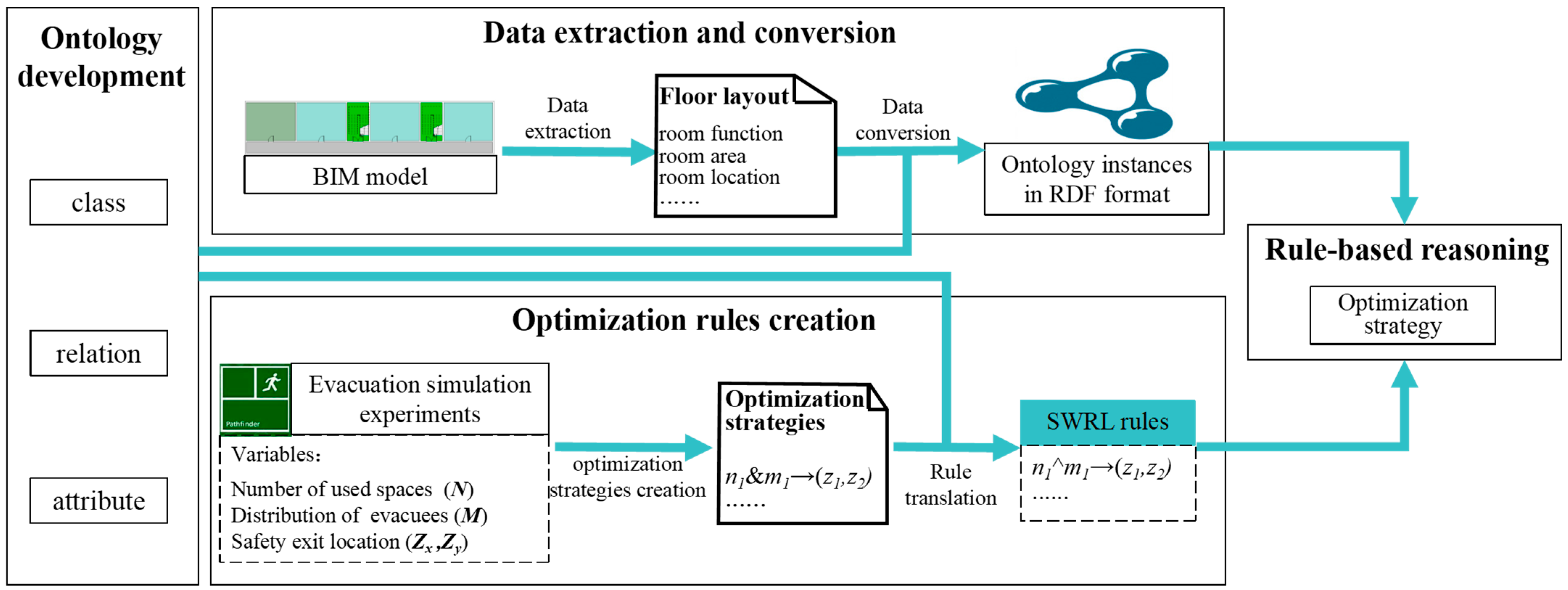
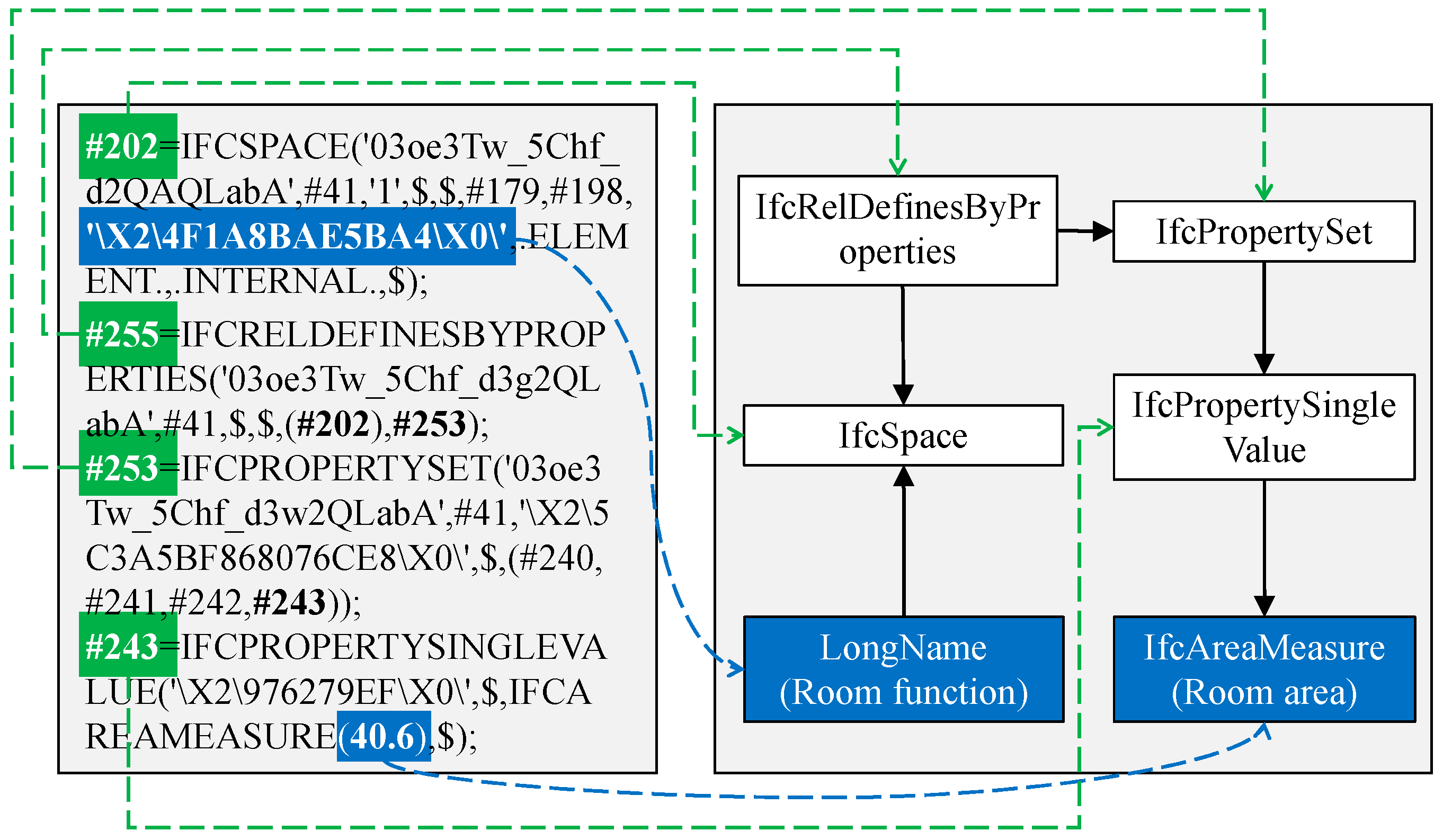
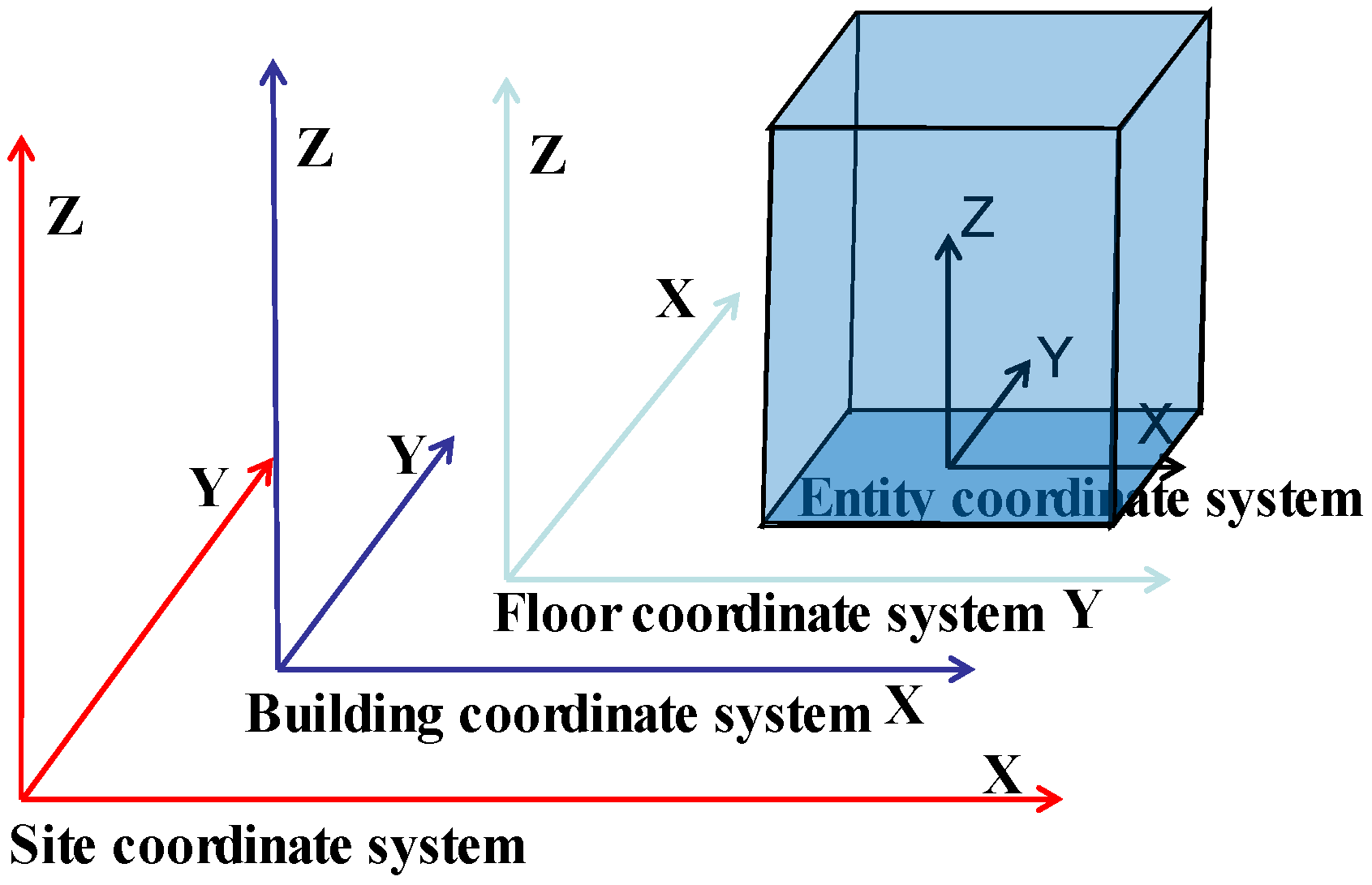
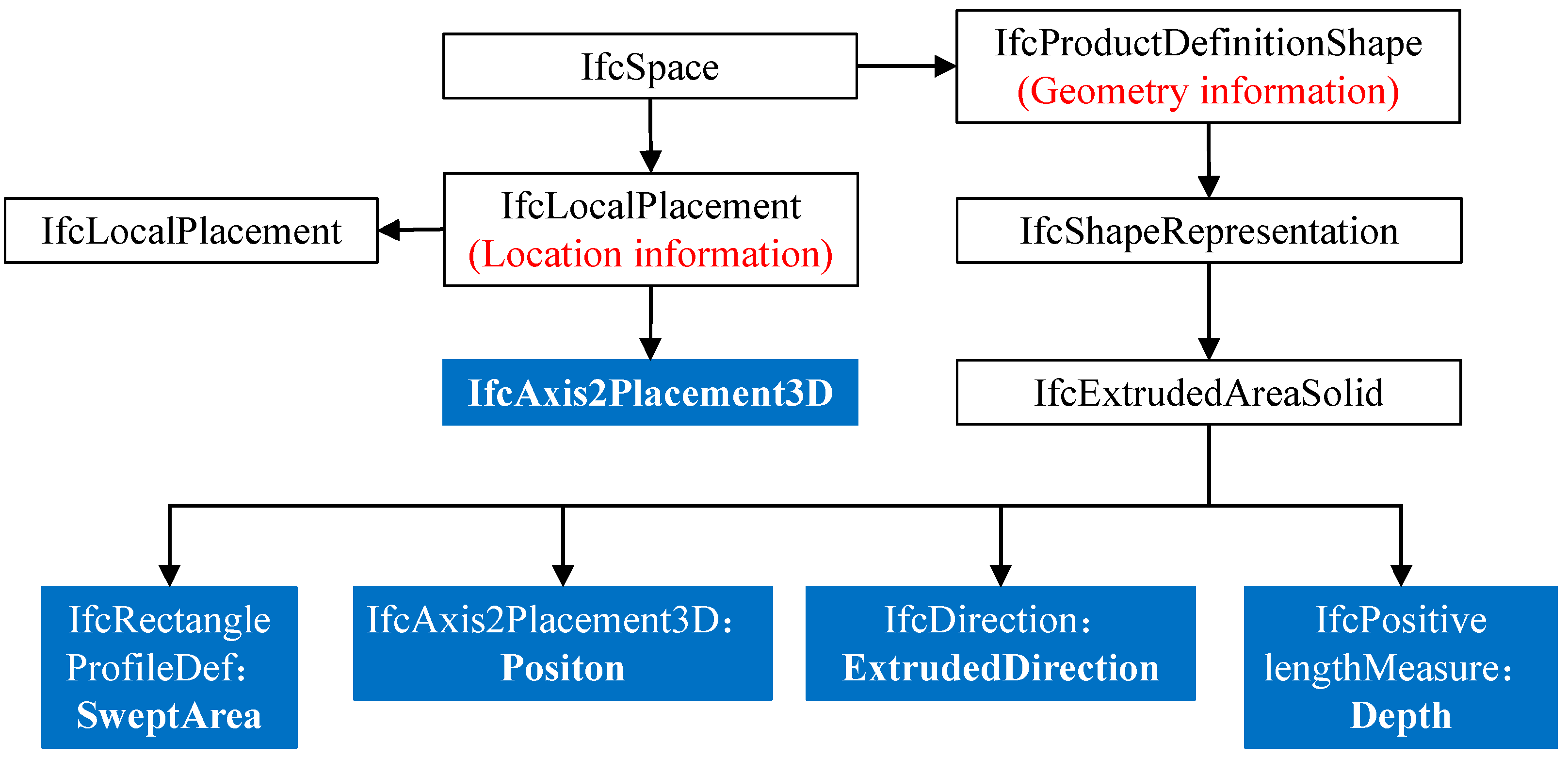

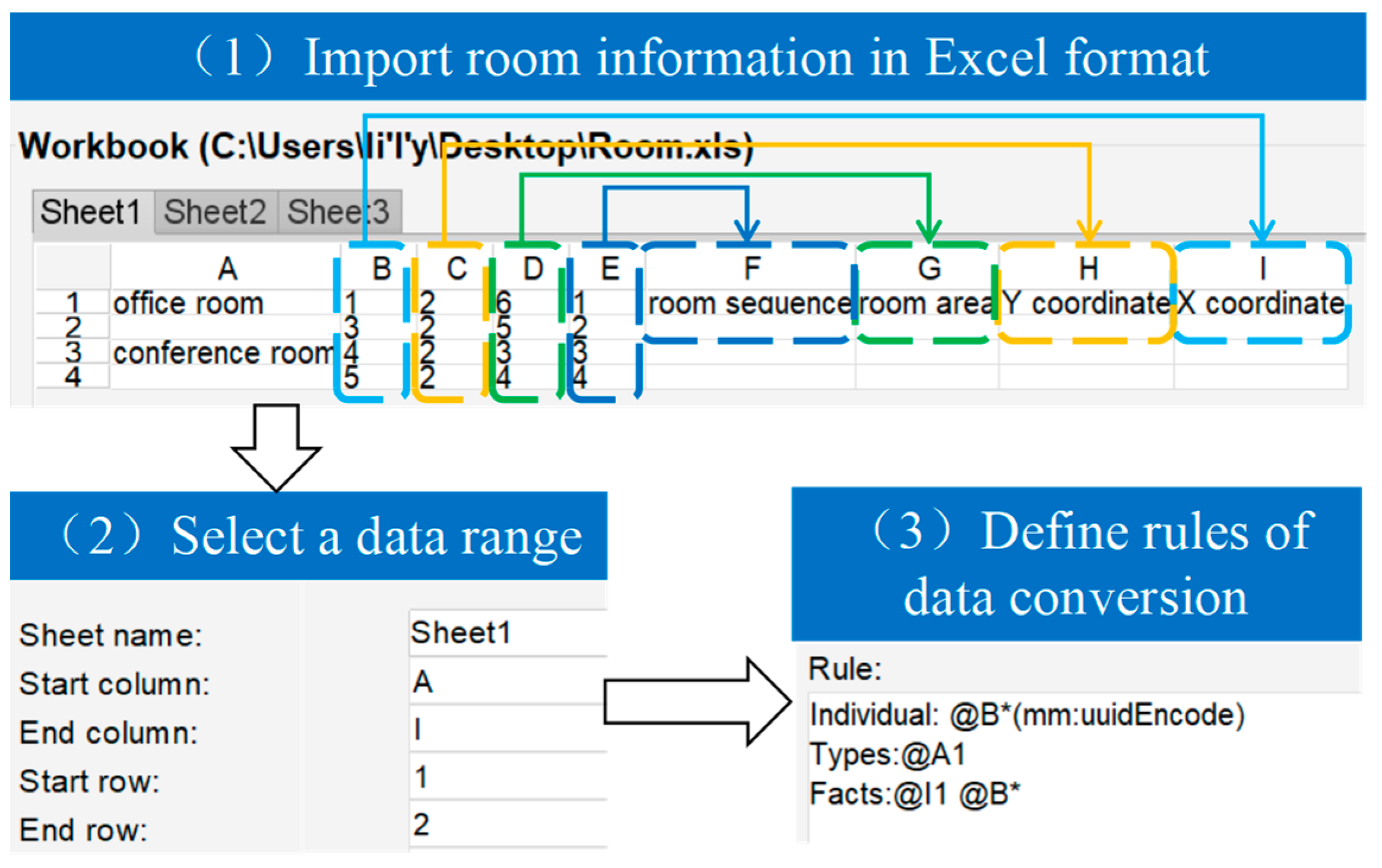
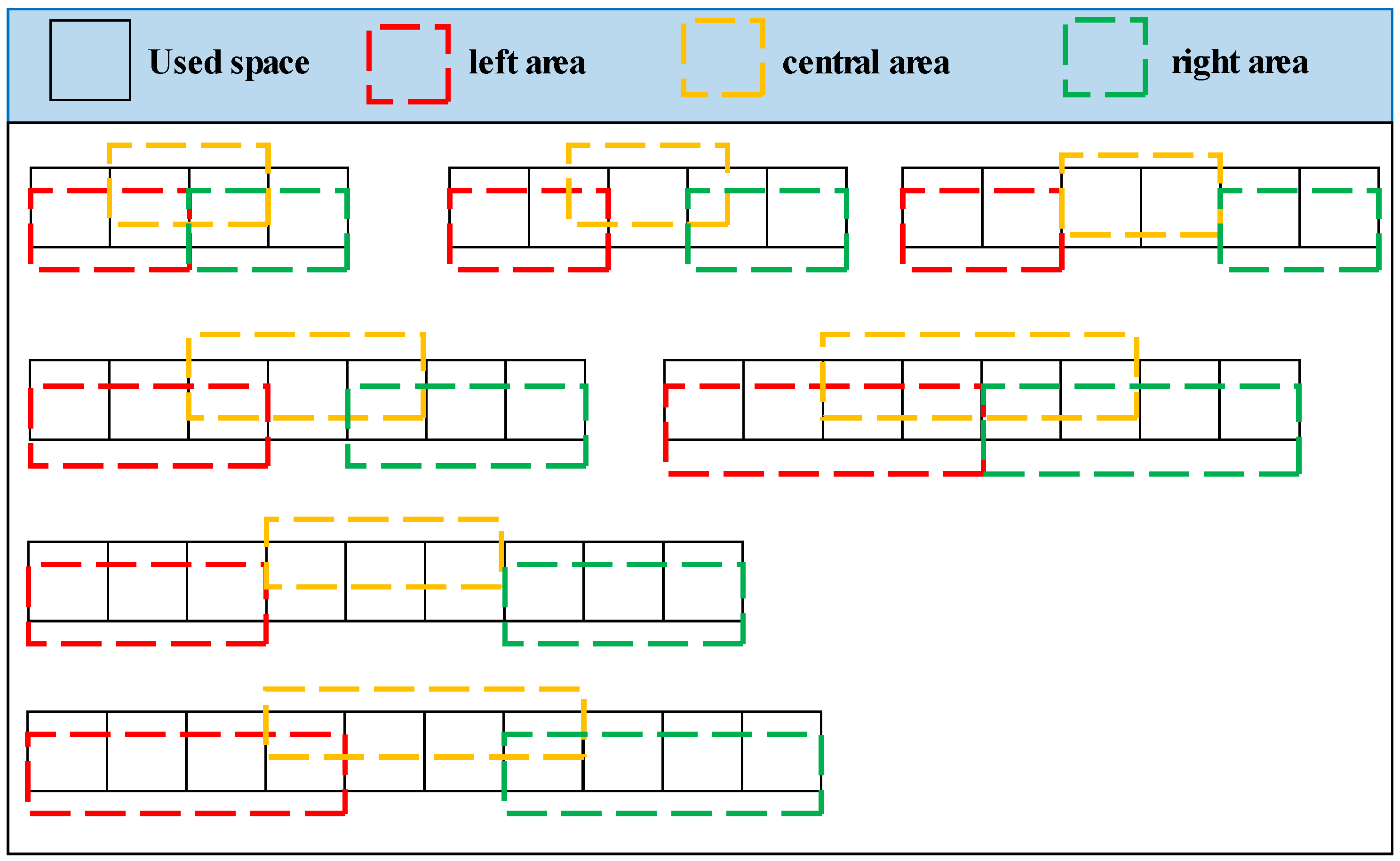
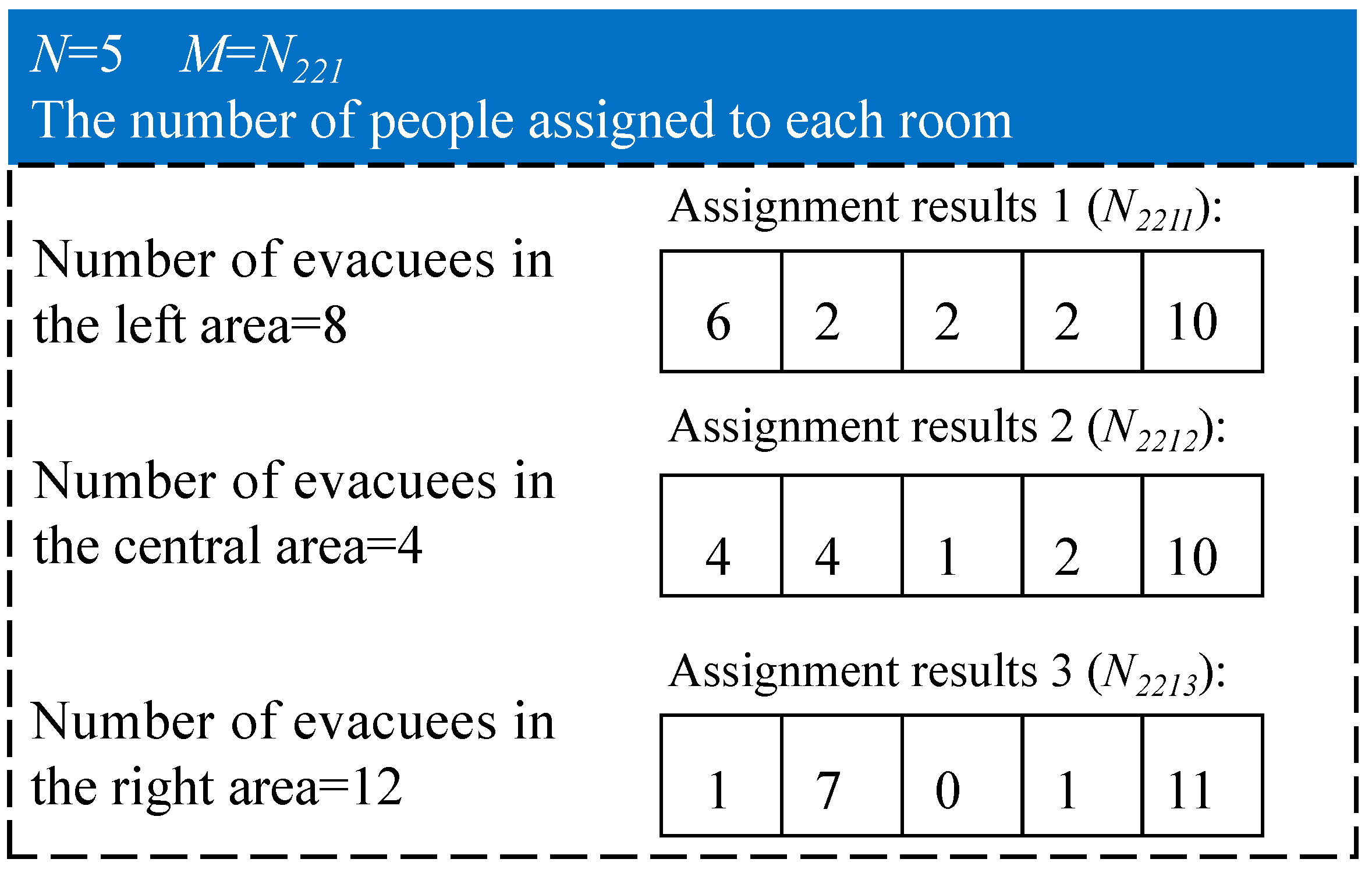


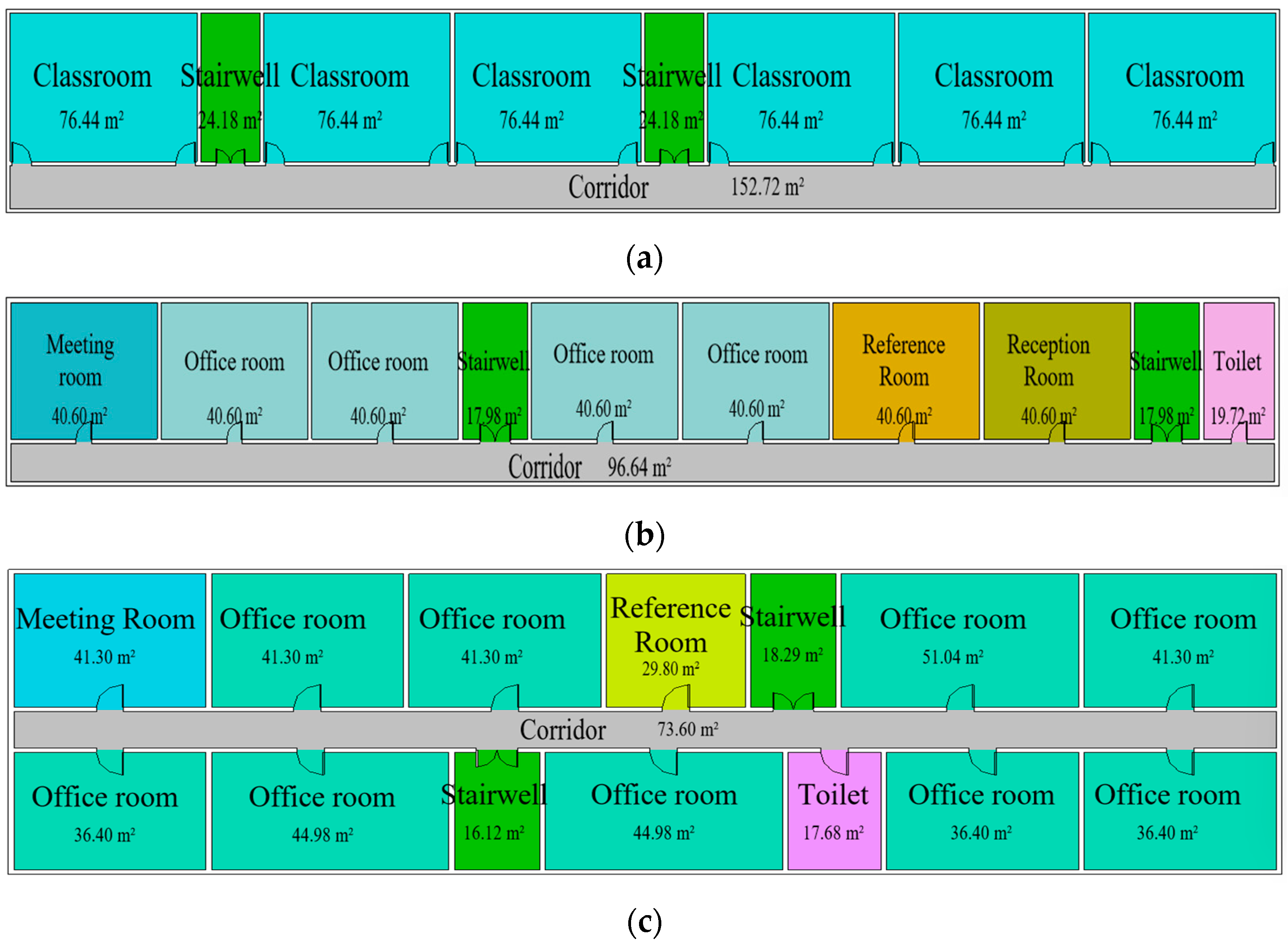
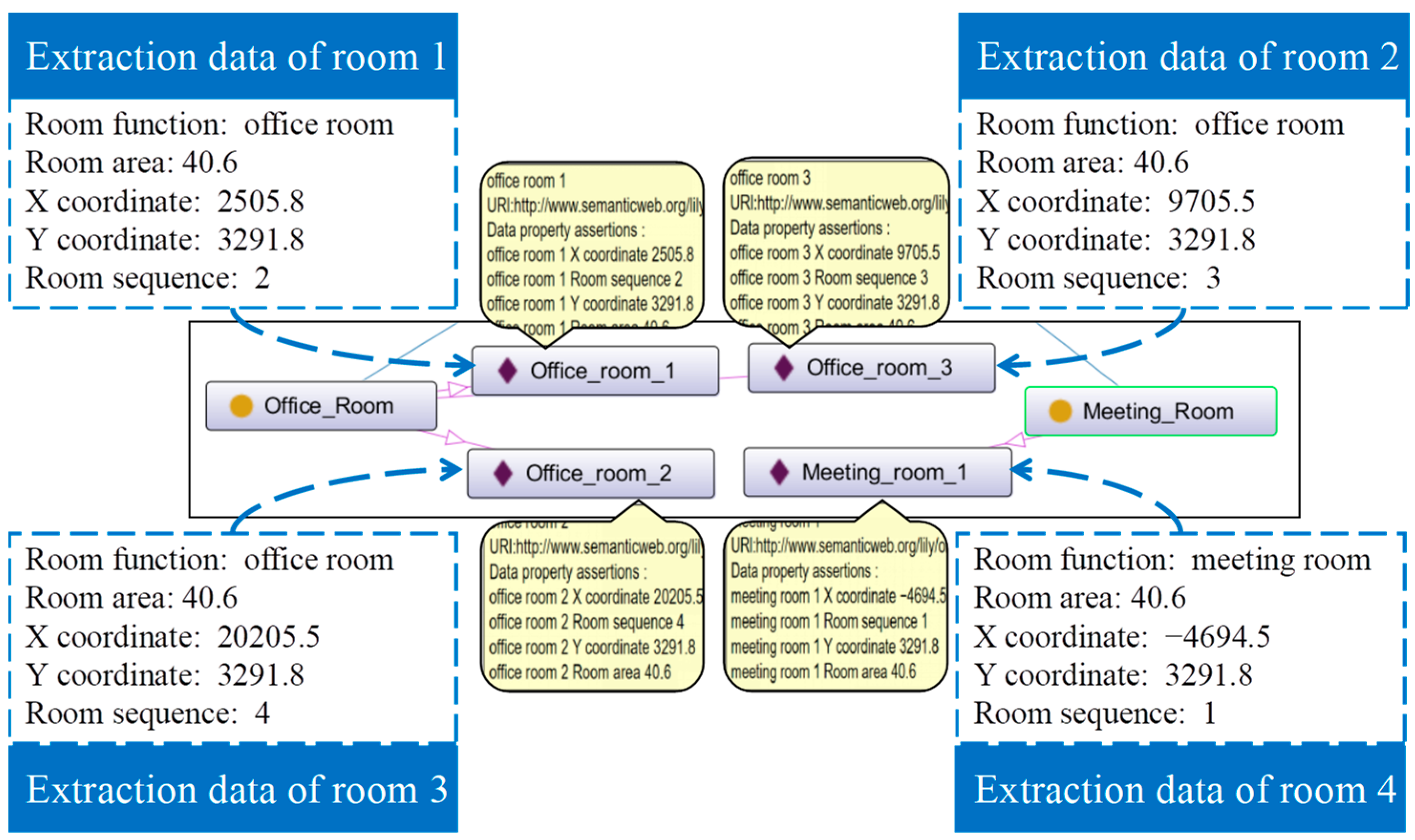
| Attribute Name | Attribute Definition Field | Attribute Format |
|---|---|---|
| X Coordinate | Building space | decimal |
| Y Coordinate | decimal | |
| Room area | Space for usage | decimal |
| Room sequence | int | |
| Number of evacuees | int | |
| Number of evacuees in the left area | Building floor | int |
| Number of evacuees in the central area | int | |
| Number of evacuees in the right area | int | |
| Number of spaces for usage | int | |
| Distribution of evacuees | string | |
| Optimal exit location | string | |
| Original exit location | string |
| Distribution of Evacuees (Left–Central–Right) | Number of Evacuees in the Left Area | Number of Evacuees in the Central Area | Number of Evacuees in the Right Area | |
|---|---|---|---|---|
| N21: Less–medium–more | N211: less (+4) medium (+4) more | 4 | 8 | 12 |
| N212: less (+4) medium (+6) more | 4 | 8 | 14 | |
| N213: less (+6) medium (+4) more | 4 | 10 | 14 | |
| N22: medium–less–more | N221: less (+4) medium (+4) more | 8 | 4 | 12 |
| N222: less (+4) medium (+6) more | 8 | 4 | 14 | |
| N223: less (+6) medium (+4) more | 10 | 4 | 14 | |
| N23: medium–more–less | N231: less (+4) medium (+4) more | 12 | 16 | 8 |
| N232: less (+4) medium (+6) more | 12 | 18 | 8 | |
| N233: less (+6) medium (+4) more | 14 | 18 | 8 | |
| N24: equal–equal–unequal | N241: equal (+4) unequal | 8 | 8 | 12 |
| N242: unequal (+4) equal | 12 | 12 | 8 | |
| N25: equal–unequal–equal | N251: equal (+4) unequal | 8 | 12 | 8 |
| N252: unequal (+4) equal | 12 | 8 | 12 | |
| Number of Used Spaces | Location of Exit 1 | Location of Exit 2 |
|---|---|---|
| n = 4 | (2–3) on the left | (1–2) on the right |
| n = 5 | (1–3) on the right | |
| n = 6, 7 | (2–4) on the left | |
| n = 8 | (3–5) on the left | |
| n = 9, 10 | (1–4) on the right |
| Reasoning Order | SWRL Rules |
|---|---|
| Reasoning the number of evacuees in rooms | Room function (?a) ^ Room area (?a, ?a Room area) ^ swrlb:divide (?x, ?a Room area, n) -> Number of evacuees (?a, ?x) |
| Reasoning the number of evacuees in each area | Example: n = 6, Reasoning the number of evacuees in the left area. Building floor (?a) ^ Number of spaces for usage (?a, ?a1) ^ swrlb:equal (?a1, 6) ^ Space for usage (?b) ^ Room Sequence (?b, ?b1) ^ swrlb:equal (?b1, 1) ^ Number of evacuees (?b, ?x1) ^ Space for usage (?c) ^ Room Sequence (?c, ?c1) ^ swrlb:equal (?c1, 2) ^ Number of evacuees (?c, ?x2) ^ swrlb:add (?x3, ?x1, ?x2) -> Number of evacuees in left area (?a, ?x3) |
| Reasoning the distribution of evacuees | Example: When reasoning the distribution of evacuees is “less-medium-more”. Building floor (?a) ^ number of evacuees in left area (?a, ?x1) ^ number of evacuees in central area (?a, ?x2) ^ number of evacuees in right area (?a,?x3) ^ swrlb:greaterThan (?x2, ?x1)^swrlb:greaterThan (?x3, ?x2) -> distribution of evacuees (?a, ”less-medium-more”) |
| Reasoning the exit location optimization strategy | Example: n = 6, the evacuation number layout is “less-medium-more”. Building floor (?a) ^ Number of spaces for usage (?a, ?a1) ^ swrlb:equal (?a1, 6) ^ distribution of evacuees (?a, “less-medium-more”) -> Optimal exit location (?a, “(2–4) on the left & (1–3) on the right”) |
| Room Function | SWRL Rules for Reasoning Number of Evacuees |
|---|---|
| Meeting room | Meeting room (?a) ^ room area (?a, ?a room area) ^ swrlb:divide (?x, ?a room area, 2) -> number of evacuees (?a, ?x) |
| Office room | Office room (?a) ^ room area (?a, ?a room area) ^ swrlb:divide (?x, ?a room area, 6) -> number of evacuees (?a, ?x) |
| Reception Room | Reception Room (?a) ^ -> number of evacuees (?a, 2) |
| Reference Room | Reference Room (?a) ^ -> number of evacuees (?a, 1) |
| Toilet | Toilet (?a) ^ -> number of evacuees (?a, 1) |
| Classroom | Classroom (?a) ^ -> number of evacuees (?a, 45) |
| The Original Design | The Shortest Evacuation Path Design | The Design Optimized by the Proposed Method | |||||
|---|---|---|---|---|---|---|---|
| Exit Location | Evacuation Time (s) | Exit Location | Evacuation Time (s) | The Optimization Strategy Obtained by Inference | Exit Location | Evacuation Time (s) | |
| Case 1 | (1–2 & 3–4) | 62.5 | (2–3 & 4–5) | 52.3 | (1–3) on the left & (1–3) on the right | (1–2 &5–6) | 50.8 |
| Case 2 | (3–4 & 7–8) | 35.8 | (2–3 & 6–7) | 29.3 | (1–3) on the left & (3–5) on the right | (1–2 & 5–6) | 22.5 |
| Case 3 | upper (3–4)& bottom (5–6) | 42.5 | upper (5–6)& bottom (2–3) | 34.5 | (1–3) on the left & (2–4) on the right | upper (1–2)& bottom (5–6) | 28.3 |
Disclaimer/Publisher’s Note: The statements, opinions and data contained in all publications are solely those of the individual author(s) and contributor(s) and not of MDPI and/or the editor(s). MDPI and/or the editor(s) disclaim responsibility for any injury to people or property resulting from any ideas, methods, instructions or products referred to in the content. |
© 2023 by the authors. Licensee MDPI, Basel, Switzerland. This article is an open access article distributed under the terms and conditions of the Creative Commons Attribution (CC BY) license (https://creativecommons.org/licenses/by/4.0/).
Share and Cite
Zhao, X.; Huang, L.; Sun, Z.; Fan, X.; Zhang, M. Design Optimization of Building Exit Locations Based on Building Information Model and Ontology. Sustainability 2023, 15, 12922. https://doi.org/10.3390/su151712922
Zhao X, Huang L, Sun Z, Fan X, Zhang M. Design Optimization of Building Exit Locations Based on Building Information Model and Ontology. Sustainability. 2023; 15(17):12922. https://doi.org/10.3390/su151712922
Chicago/Turabian StyleZhao, Xuefeng, Lingli Huang, Zhe Sun, Xiongtao Fan, and Meng Zhang. 2023. "Design Optimization of Building Exit Locations Based on Building Information Model and Ontology" Sustainability 15, no. 17: 12922. https://doi.org/10.3390/su151712922
APA StyleZhao, X., Huang, L., Sun, Z., Fan, X., & Zhang, M. (2023). Design Optimization of Building Exit Locations Based on Building Information Model and Ontology. Sustainability, 15(17), 12922. https://doi.org/10.3390/su151712922







